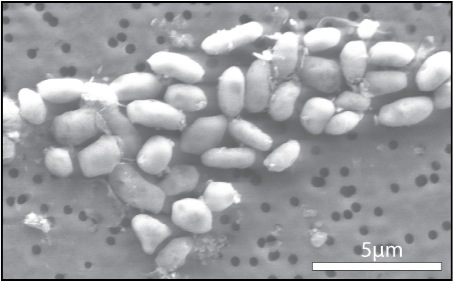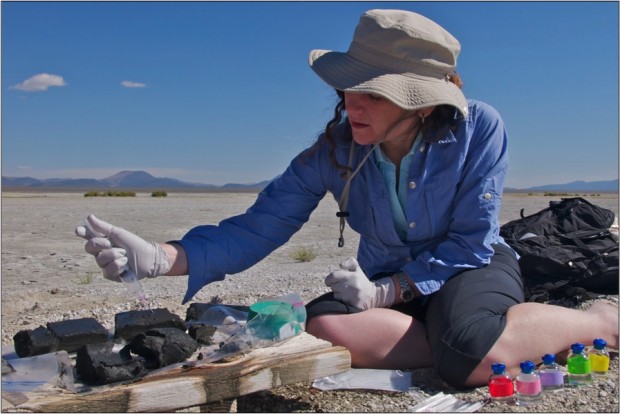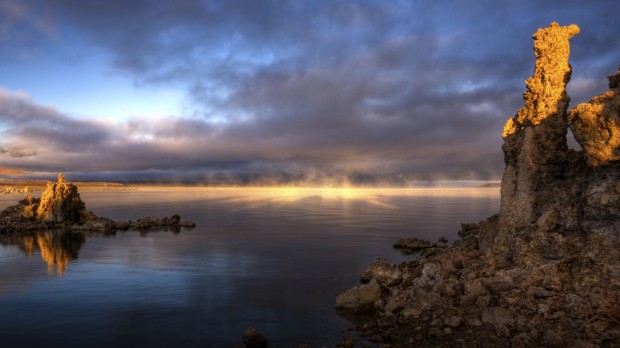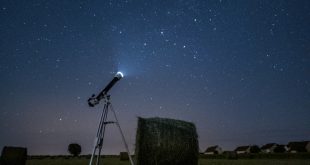On November 30, I blogged NASA’s announcement of a news conference the agency had called for 2 PM today to “discuss an astrobiology finding that will impact the search for extraterrestrial life.” Acknowledging NASA’s customary hyperbole, I concluded my post with a tiny bet:
If I were to place a bet on the subject of the upcoming press conference, I�d wager (only a penny ante, mind you) that it will involve the discovery of a terrestrial shadow biosphere. Indeed, discovery of such an esoteric domain of life, either in the past or the present, would be tantamount to the discovery of extraterrestrial life�right here on Earth.
Did I win my bet? As I expected, the answer isn’t so simple. NASA’s announcement, while revealing the discovery of organisms that give conventional biochemistry a pretty weird twist, does not incontrovertibly reveal the existence of a shadow biosphere. Many hardboiled science journalists who were in on the embargo are now wagging fingers at the wild speculations offered in advance of today’s press conference.
Scattershot speculations should be expected in a case like this, which combined NASA’s infamously hyperbolic approach to astrobiology with monopolistic embargo policies of the journal Science, where the scientific findings announced today are officially published (for an acute critique of this tension in science journalism, visit Ivan Boransky’s Embargo Watch). The wildest speculations were offered after the embargo was lifted; see the frenzied coverage Gizmodo gave to the story, claiming erroneously the discovery of a “new life form that doesn’t share the biological building blocks of anything currently living in planet Earth.” (Solid early coverage can be found at Nature and at Discover‘s Bad Astronomy blog.)
But if the fancies were wild, the naysayers risk going too far in downplaying these results. For they furnish a glimpse of fundamental challenges to some of the basic assumptions of the biological sciences. Indeed, the results presented today might indicate that the concept of a shadow biosphere is not all that useful�or that it does exist, and we’re already a part of it.

NASA’s press conference concerned a microbe, GFAJ-1, discovered by Felisa Wolfe-Simon, a NASA astrobiology fellow connected with the US Geological Survey. The microbe, which Wolfe-Simon found in the alkaline muds of California’s Mono Lake, is part of a group of salt-loving bacteria called the Halomonadaceae. They are not altogether novel�indeed they share physiological and biochemical features common to all bacteria, including DNA. They’re emphatically part of the “Tree of Life” as we conventionally define it. What’s different about GFAJ-1 is, at a minimum, that it can handle large concentrations of arsenic in its environment, and even reproduce in its presence. Wolfe-Simon argues that the bacterium is not only tolerating this normally-toxic substance, but incorporating it into its DNA, replacing the chemically similar (but far less reactive) phosphorous. Dr. Stephen Benner, a chemist and member of NASA’s Astrobiology Institute, joined today’s press conference to caution that more work is needed before this claim can be proven.
GFAJ-1’s reaction to arsenic might represent an early fork in the evolution of the biosphere, or its response to arsenic might be a quite recent adaption. This biochemistry might be unique, or it might be relatively common. But it hints at a broad spectrum of biotic possibilities extending beyond the borders of the biosphere as we know it. Maybe life isn’t a tree at all, but a net�a system that sifts the chemical possibilities of a broad spectrum of environments for biochemical niches to pioneer and exploit. As Wolfe-Simon was quick to point out today, answering the questions GFAJ-1 poses will take decades�more than long enough to satisfy the career needs of one fast-advancing young scientist.

As Wolfe-Simon’s work on GFAJ-1’s biochemistry shows, it can be extraordinarily difficult to isolate and identify novel forms of life, even here on Earth�let alone on the surfaces of far-off moons in our own solar system, much less the still-mysterious exoplanets orbiting distant starts. You can go to Mono Lake and collect a cup of mud laced with GFAJ-1, and yet the its fundamental attributes are elusive in the extreme. While the discovery of these arsenophiles offers astrobiology a powerful goad for new research, it also reminds us how difficult it’s going to be ever to know what we’re looking at when we peer into distant worlds for evidence of extraterrestrial life.
But barring some major falsification to Wolfe-Simon’s findings, the news is rather extraordinary. To say that this is not the case is to deploy a sad contradiction, reinforcing the assumption that little green men are the only result worth waiting for. Well, we probably never will get those little green men. The universe for all its mysteries still seems as hostile to them as it does to us. But what we do have in the discovery of GFAJ-1 strengthens the possibility that amidst the great silence we continue to find everywhere we listen, life finds many ways.
 Gearfuse Technology, Science, Culture & More
Gearfuse Technology, Science, Culture & More



